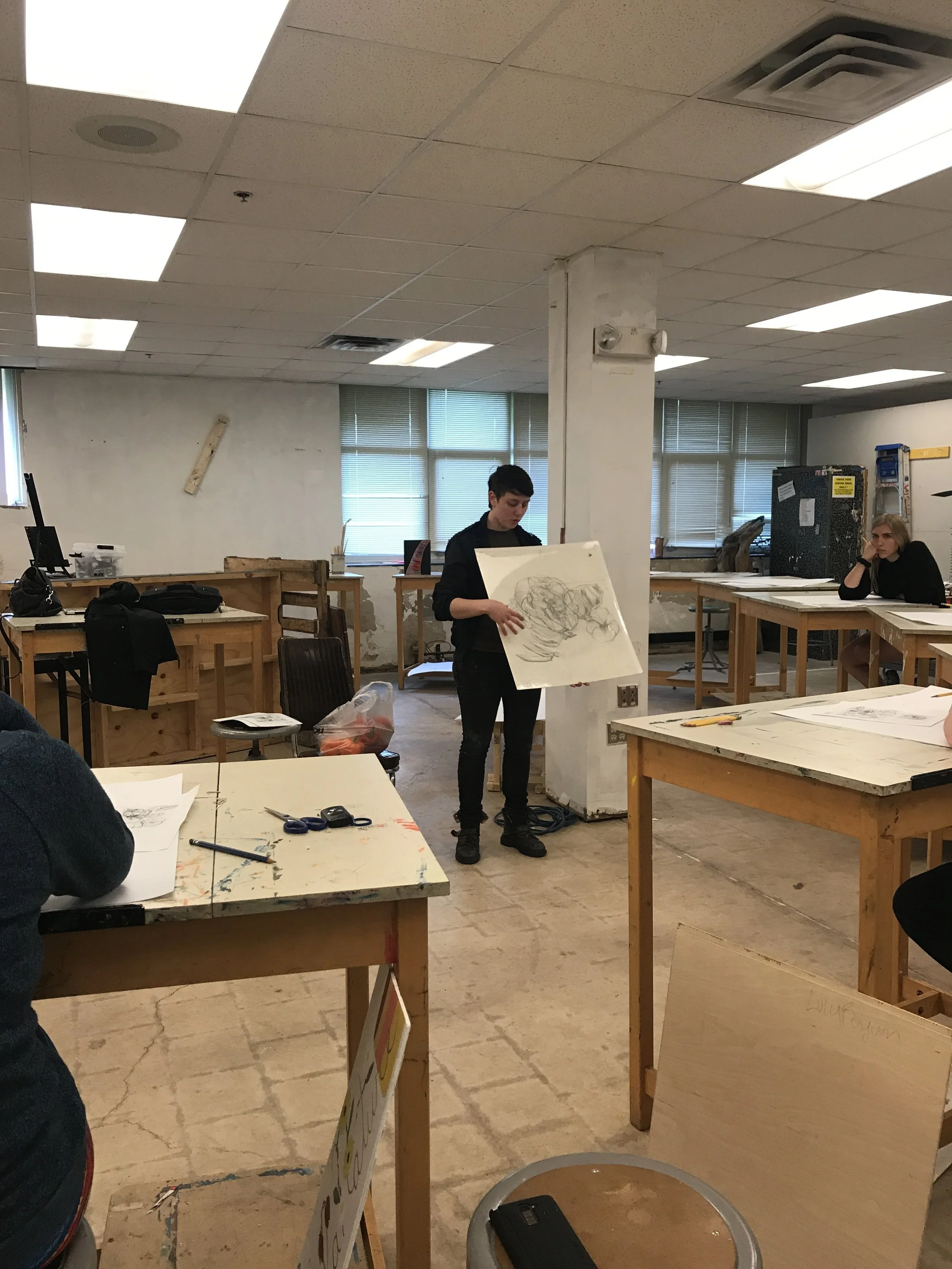Name of Project: Incredi-bell Peppers
Grade Level or Age of Participant: High School Juniors
School, Teacher and Classroom: Perpich Center for Arts Education, Pat Benincasa, Drawing
MCAD Teaching Artist: Roman Feldhahn
Number of Students: 10
Visual Arts Content or Standards
Grades 9-12
1. Artistic Foundations
1. Demonstrate knowledge of the foundations of the arts area.
Visual Arts 9.1.1.5.1
1. Analyze how the elements of visual art including color, line, shape, value, form, texture and space; and principles such as repetition, pattern, emphasis, contrast and balance are combined to communicate meaning in the creation of, presentation of, or response to visual artworks.
Overview of Project
The students will be creating an in-class observational drawing depicting multiple stages of a bell pepper being cut open and into slices. They will superimpose the stages on the drawing on top of one another to create a sense of separation of the dissected form over time.
“Big Ideas”/ Essential Question(s)
Students will explore the spatial qualities of an object as they dissect it and understand how structural elements inform a drawing. The big idea is that they consider the parts of a whole as their own forms and recognize how they function in the context of one another.
Student Outcome Objectives
Students will:
Describe: Students will describe the form of the pepper with a graphite drawing.
Manipulate: Students will manipulate the form by cutting it open in a multi-step process. Students will also manipulate their drawings by layering the open forms on top of the closed ones.
Relate: Students will show the relationship between forms and illustrate how the inside of the pepper relates to its overall composition.
Prior Knowledge
Students must have basic observational drawing skills. T
Examples of Artwork
I will bring in my own personal example of the exercise that I will show to the students before the lesson to describe the idea and anticipated outcome of the project. I will also compile a handout of examples that will include images of drawings of peppers and their slices and credit the image sources.
Assessment
Student’s learning and engagement will be assessed through an in-class critique following the drawing exercise. Each student will have an opportunity to share their experience and take comments on their work. Quality work will demonstrate completion of each of the 3 steps of the lesson and will spark a conversation during critique. Quality work will be determined by a thoughtful composition and resolution of the drawing, addressing each slice and form individually while keeping in mind their relationship to one another.
Materials
Paper: 10 sheets (provided) 24" x 24"
Graphite pencils: 10 (owned by students/provided), soft
Bell peppers: 10
Knife: 2-5
Learning Activities and Timing
1. Introduction and breakdown of lesson, passing out handouts and materials, and explanation of steps involved in the lesson with time for questions. (10 minutes)
2. Students will create their initial drawing of the pepper, taking into consideration placement and composition. The drawing of their entire pepper should take up about ¼ of the page. (15 minutes)
3. Students will slice the pepper in half with a single cut. They can choose how they slice the pepper whether it is vertically, horizontally, or otherwise. They will then draw each half in relation to their first drawing while focusing on describing the inner structure of the pepper. (15 minutes)
4. Students will slice the rest of their pepper however they choose using a minimum of 2 more cuts. They will then draw these slices and the remains of their pepper on top of or around their initial drawing, taking their placement and scale into consideration. (15 minutes)
5. After they finish step 4, students will be guided in aclass critique of the drawings with a focus on form, contrast, depth, and composition. We will go through and spend 1-2 minutes on each drawing so that students can adequately give each other feedback and reflect on the lesson.
Teaching Artist Reflection
I anticipate that students may be hesitant to overlap their drawings with the fear that they may be covering up work that they’ve already done in the previous steps. To combat this, I will provide examples of how layering a drawing can improve understanding of the dimensions of the content. This project is applicable to their curriculum as it is a drawing class and the lesson will utilize multiple skills that they have learned throughout the semester. Students will share their work among each other by hanging them for critique, and the work will be photographed so that it can be shared as a teaching resource. The critique will also serve as a platform for evaluating work and receiving feedback on both individual works and the lesson as a whole.







